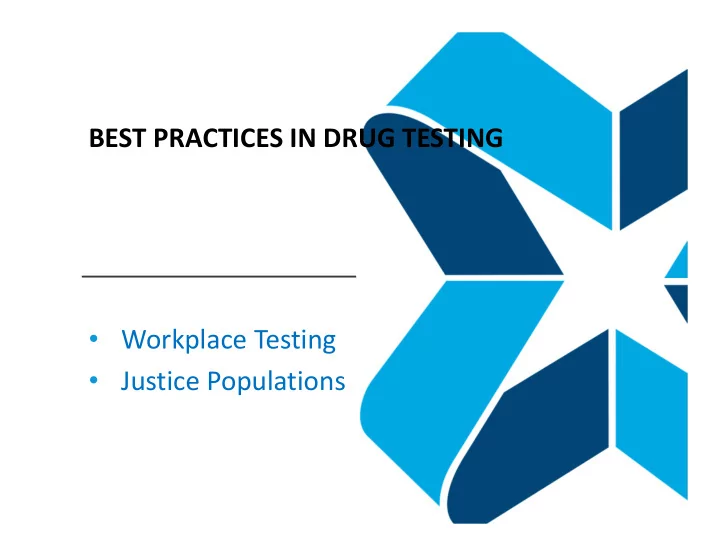

BEST PRACTICES IN DRUG TESTING • Workplace Testing • Justice Populations
AUDIENCE POLL / Who are you? 1. Administrator / Human Resources 2. Corrections / Case Manager 3. Business 4. Law Enforcement 5. Health Services 2 Justice Clearinghouse Oct 2017
OVERDOSES SURPASS AUTO DEATHS 3 Justice Clearinghouse Oct 2017
ACROSS ALL AGE GROUPS 4 Justice Clearinghouse Oct 2017
ACROSS ALL DEMOGRAPHICS 5 Justice Clearinghouse Oct 2017
HEROIN OPIOID DEATHS 6 Justice Clearinghouse Oct 2017
ORIGINS OF DRUG TESTING Dawn of the Industrial Age Nixon Administration Reagan Administration 7 Justice Clearinghouse Oct 2017
CASE LAW 4 th Amendment Reasonable expectation to privacy Special needs exclusions 8 Justice Clearinghouse Oct 2017
RATIONALES FOR DRUG TESTING 1. Screen Job Applicants 2. Workplace Safety Protection Productivity 3. Contain Healthcare Costs 4. Deter drug use and relapse/ prevention 5. Determine Accident Liability 6. Encourage Healthy Living and Families 7. Enforce Court Orders / Surveillance 9 Justice Clearinghouse Oct 2017
WORKPLACE TESTING TRENDS 5/16/17 Report on Workplace Testing Overall positive rate of 4.2% for 2016 Marijuana has increased each of the past three years CO and WA are twice the national average 10 Justice Clearinghouse Oct 2017
WORKPLACE TESTING Pre employment Randomized verification testing Testing for probable cause Testing following accident or injury 11 Justice Clearinghouse Oct 2017
WORKPLACE IMPLEMENTATION HURDLES Workforce resistance Downsides Workforce adoption / trust 12 Justice Clearinghouse Oct 2017
WORKPLACE SUMMARY Purpose Research Policies Educate Fidelity 13 Justice Clearinghouse Oct 2017
JUSTICE POPULATIONS Diversion Juveniles Pretrial Adults Family Courts Transferred Youth CPS Therapeutic Courts Jails Target populations Drug Probation Alcohol Prisons Co‐occurring disorders Parole 14 Justice Clearinghouse Oct 2017
INEFFECTIVE DRUG POLICIES WAR on DRUGS Mass Incarceration Family Devastation Increased Racial Inequality Jails and Prisons used to treat mental illness 10/12/2 15 Justice Clearinghouse Oct 2017 017
WHAT HAS BEEN LEARNED? Therapeutic approaches are proven to work when implemented according to design. Case management is informed by assessments and should be tailored to personal needs. (RNR) Drug testing encourages drug abstinence. Regular drug testing coupled with treatment improves outcomes and lessens risk. Don’t mix low and low‐medium risk offenders with higher risk offenders. 16 Justice Clearinghouse Oct 2017
EVIDENCE BASED KNOWLEDGE FOR TESTING OFFENDER POPULATIONS National Association of Drug Court Professionals Adult Drug Court Best Practice Standards Vol II 2015 10 Principles of a Good Testing Program Michigan Association of Treatment Court Professionals Standards, Best Practices, Promising Practices March 2017 17 Justice Clearinghouse Oct 2017
NATIONAL ASSOCIATION OF DRUG COURT PROFESSIONALS Frequent Testing Random Testing Duration of Testing Breadth of Testing Witnessed Collection Valid Specimens Accurate and Reliable Methodology Rapid Results and Consequences Participant Contract 18 Justice Clearinghouse Oct 2017
MICHIGAN ASSOCIATION OF TREATMENT COURT PROFESSIONALS Detailed manual for court, officer and donor Client contract expectations & responsibilities Scientific, Valid testing Methodology Collection witnessed, random & unannounced Confirmed testing unless admits to use Validity testing/ diluted, adulterated, tampered Rigid interpretation guidelines Eliminate interpretation of urine levels Behavior change intervention strategies Caveat – drug detection is one dimension 19 Justice Clearinghouse Oct 2017
DRUG COURT SELECTION PROCESS High needs for drug treatment Seriously addicted individuals Preadmission screening and evaluation assessment Multi‐discipline team case management Approved by the prosecutor Voice given to the victim 20 Justice Clearinghouse Oct 2017
WHAT OF THE OTHER POPULATIONS? Agencies and officers need guidance GAP – Lower risk offenders Most offenders come into the system with a history of drug and/or alcohol use and are Court ordered to test How to apply EBP to case management Drug testing training guides for officers 21 Justice Clearinghouse Oct 2017
JUSTICE CLIENTS SUMMARY Purpose Research Policies Educate Fidelity 22 Justice Clearinghouse Oct 2017
COLLECTIONS STANDARDS Direct Visual Verification Chain of Custody Certified Laboratories Confirmation Testing Expert Testimony 23 Justice Clearinghouse Oct 2017
VISUAL MONITORING COLLECTION Female Restroom Male Restroom One way mirror to view collection Bluing agent in toilets No hot water No chemicals in area Remove excessive clothing No items allowed in restroom 24 Justice Clearinghouse Oct 2017
EVASION Diluted Adulterant Substitution Devices 25 Justice Clearinghouse Oct 2017
CHAIN OF CUSTODY / CONTROL Document of Order Collection details Transportation manifest Laboratory check in Verification of sample and Chain Bar coded to order and testing device Results Certification 26 Justice Clearinghouse Oct 2017
DETECTION TIMES Media Approximate Detection Period Urine 24‐72 hours Oral Fluid 12‐36 hours / 6‐8 hours THC Head hair: 14‐90 days prior Hair Body hair: 30‐365 days prior Blood 8‐36 hours Sweat 1‐4 weeks (period patch is worn) 27 Justice Clearinghouse Oct 2017
URINE DETECTION TIMES Stimulants: Amphetamines, Cocaine, Ecstasy, 24‐72 hours Bath Salts Narcotics / Narcotic Analgesics: Methadone, Opiates, Propoxyphene 24‐72 hours Sedative Hypnotics Barbiturates, Benzodiazepines 24‐72 hours / 2‐6 wks* Hallucinogens: Marijuana 24‐72 hrs / 2‐6 wks* PCP, LSD 2‐5 days Depressants: Alcohol 1‐12 hours Ethyl Glucuronide (EtG) 8‐72 hours Fentanyl 2 ‐3 days 28 Justice Clearinghouse Oct 2017
GENERAL INFORMATION Marijuana Amphetamines Opiates EtG 29 Justice Clearinghouse Oct 2017
TRENDING DRUGS Dextromethorphan (dxm) Bath Salts SPICE Kratom 30 Justice Clearinghouse Oct 2017
TYPES OF EXPOSURE Sexual intercourse with a drug user Touching a contaminated surface Inhaling second‐hand smoke Consuming products cooked with alcohol Hand Sanitizer Mouthwashes 31 Justice Clearinghouse Oct 2017
INCIDENTAL EXPOSURES Hand sanitizer applied every 15 minutes for 8 hours – Negative Gargling mouthwash 3 times a day for 5 days – Negative Gargling mouthwash 4 times a day for 78 hours – Negative Eating beer brats – Negative Communion wine – Negative 32 Justice Clearinghouse Oct 2017
THANK YOU For viewing this presentation MARK HENDERSHOT Chief Information Officer mhendershot@tascsolutions.org
Recommend
More recommend